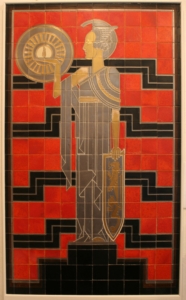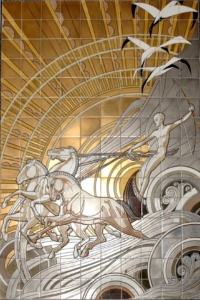Le Musée du Carrelage Gilliot & Roelants ouvre l’année des 125 ans de Gilliot & Cie avec une nouvelle exposition temporaire qui se déroulera de fin juin 2022 à début juin 2023.
Cette fois, l’accent est mis sur la production belge de carrelages de l’entre-deux-guerres. Après la fin de la Première Guerre mondiale, les changements de goût ont progressivement conduit à un changement radical de la gamme de carreaux. Les fabricants les plus performants ont bien résisté et remportent également un succès international considérable au cours de cette période.
Pendant la Première Guerre mondiale, l’industrie belge de carrelages s’était en grande partie arrêtée en raison des destructions et des réquisitions par l’occupant allemand et du manque de commandes. Dès la fin de 1918, les machines encore disponibles dans les différentes fabriques sont remises en marche au plus vite. La campagne de reconstruction dans les « régions dévastées » a nécessité d’énormes quantités de matériaux de construction en peu de temps.
Au départ, les fabricants de carreaux prenaient à peine le temps de renouveler en profondeur la gamme de décors de carreaux de sol et de mur.
De nouvelles idées sur le style – en particulier l’Art Déco et le modernisme – couplées à des facteurs externes tels que la hausse des salaires et surtout la crise financière des années 1930, ont provoqué un changement profond.
On en trouve de beaux exemples dans la belle collection du musée de carrelage Gilliot & Roelants, en grande partie l’œuvre de Joseph Roelants (1881-1962), le plus important dessinateur d’après-guerre de la manufacture Gilliot.
Les expositions universelles jouaient un rôle important à cette époque. Gilliot Hemiksem a impressionné avec son propre pavillon à l’exposition universelle de Bruxelles en 1935. Ce petit palais formait une synthèse harmonieuse de style classique et d’art déco discret et présentait de nombreuses nouvelles applications pour le matériau céramique. Il a donc été salué par divers décorateurs et architectes nationaux et étrangers comme l’une des réalisations les plus réussies de l’exposition.
La période de l’entre-deux-guerres est amplement illustrée dans la nouvelle exposition temporaire sur la base de divers carreaux et panneaux inédits de la collection Pozzo de la Fondation Roi Baudouin et des réserves du Musée de Carrelage Gilliot & Roelants, complétés par des photos uniques et des documents des archives Gilliot et des archives de l’ancien collaborateur talentueux Karel Hadermann qui, associés à divers chefs-d’œuvre de la collection permanente, font revivre cette période exceptionnellement fascinante de l’histoire du design belge.


Panneaux somptueusement élaborés avec Hélios sur sa voiture solaire à droite et Athéna à gauche, collection permanente Musée de Carrelage Gilliot & Roelants.





